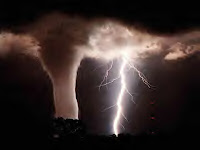
In this photo taken with a fisheye lens, people watch villain Bane on the screen during the midnight premiere of "The Dark Knight Rises" inside the Liberty Science Center IMAX theater Friday, July 20, 2012, in Jersey City, N.J. A gunman in a gas mask barged into a crowded Denver-area theater during a midnight premiere of the Batman movie on Friday, July 20, 2012, hurled a gas canister and then opened fire, killing 12 people and injuring at least 50 others in one of the deadliest mass shootings in recent U.S. history.
Associated Press
In the hours since the tragic shooting in Aurora, Colo., details about the life of the suspected gunman, 24-year-old James Holmes, and his motives remain obscure.
But a cloud of theories about violence, each accompanied by its own roster of statistics and experts, arises each time an event like this occurs, in an attempt to explain or at least contextualize the shocking episode.
Indeed, a firestorm of press coverage has reignited a decades-old debate about the influence of violent media on those who consume it. Was Holmes, who according to some reports strode into the theater dressed as Batman's nemesis the Joker, affected by violent games or movies like those of the franchise he invaded? Or was his choice of venue calculated to attract the greatest number of victims?
Insufficient evidence is available to draw conclusions yet, if it ever will be, about the twisted logic behind the tragedy in Colorado. But each time a trauma like this occurs, the statistics rolled out offer a conflicted picture of American society: violence in the media we consume continues to increase, and many researchers insist it leads to increased aggression and desensitization in youth. Others are convinced violent media has no effect.
Meanwhile, real-life violence has dropped precipitously over the last 30 years, and mass murders like the Aurora shooting make up a tiny fraction of violent crimes. But these traumas reopen conversation about violent media as Americans on both sides of the debate struggle to explain a senseless act.
Violent media's influence
Researchers began to study the possible effects of violence in the media in the 1950s, with the introduction of the television. Since then the number of studies on the issue has exploded — the Center on Media and Child Health website, operated by Children's Hospital Boston, lists 368 different studies on television and movies and their relationship to bullying and violence in children. The site also provides 125 studies about the effects of video and computer games on bullying and violence in youth.
The articles focus on different age groups and genders. They also offer different results. A longitudinal study from last year evaluating 700 elementary school age children found that those who witnessed violence, including television violence, were more likely to consider it "normal." Researchers concluded that this desensitization could mean these children were more likely to use aggression with others.




